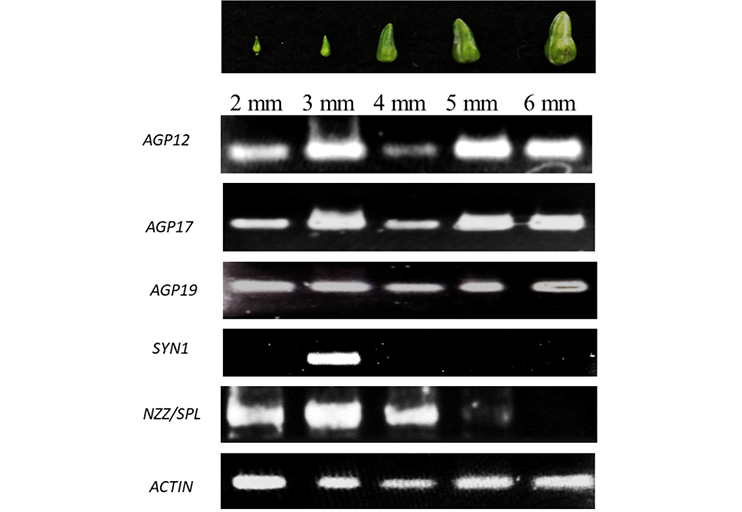Expresión de AGP12 y AGP17 durante el desarrollo del Mega gametofito en Ricinus communis
DOI:
https://doi.org/10.29312/remexca.v16i2.3407Palabras clave:
arabinogalactoproteínas, desarrollo reproductivo, diferenciación, megagametofitoResumen
El desarrollo del gametofito femenino de las angiospermas está controlado por múltiples factores, genéticos, hormonales, posicionales y epigenéticos. Las arabinogalactoproteínas son un grupo de proteínas que actúan tanto de manera estructural como en señalización durante el desarrollo, particularmente del saco embrionario. Durante 2018-2020 se analizó el desarrollo del gametofito femenino en plantas de Ricinus communis establecidas en el campo experimental del Tecnológico Nacional de México-Instituto Tecnológico de Roque. Ricinus communis es una especie que ha cobrado importancia para la producción de biocombustibles y biorremediación. El objetivo del presente trabajo fue analizar la expresión de AGP12 y AGP17 asociado con el desarrollo del gametofito femenino en etapas tempranas de desarrollo, a través de RT-PCR y qRT-PCR, en contraste con genes marcadores de las primeras divisiones celulares que actúan durante la megagametogénesis. Se encontró que ambos genes presentaron patrones de expresión semejantes, con disminución de expresión en el inicio de la meiosis y otra durante la maduración del óvulo y emisión de estigmas.
Descargas
Citas
Acosta-García, G. and Vielle-Calzada, J. P. 2004. A classical arabinogalactan protein is essential for the initiation of female gametogenesis in Arabidopsis. Plant Cell. 16(10):2614-2628. https://doi.org/10.1105/tpc.104.024588.
Chen, G. H.; Sunab, J. Y.; Liua, M.; Liua J. and Yang, W. C. 2014. SPOROCYTELESS is a novel embryophyte-specific transcription repressor that interacts with TPL and TCP proteins in Arabidopsis. Journal of Genetics and Genomics. 41(12):617-625.
Cheng, C. Y.; Mathews, D. E.; Eric-Schaller, G. and Kieber, J. J. 2013. Cytokinin‐dependent specification of the functional megaspore in the Arabidopsis female gametophyte. The Plant Journal. 73(6):929-940. https://doi.org/10.1111/tpj.12084.
Demesa-Arévalo, E. and Vielle-Calzada, J. P. 2013. The classical arabinogalactan protein AGP18 mediates megaspore selection in Arabidopsis. The Plant Cell. 25(4):1274-1287.
Erbasol, I.; Palovaara, J. and Groß-Hardt, R. 2019. Development and function of the flowering plant female gametophyte. Ed. Current Topics in Developmental Biology. 131(1):401-434. https://doi.org/10.1016/bs.ctdb.2018.11.016.
FAOSTAT. 2020. Producción nacional de semilla de higuerilla en México 2018. Organización de las Naciones Unidas para la Alimentación y la Agricultura.
Gasser, C. S. and Skinner, D. J. 2019. Development and evolution of the unique ovules of flowering plants. Current topics in developmental biology. 131(1):373-399. https://doi.org/10.1016/bs.ctdb.2018.10.007.
Hernández-Lagana, E.; Rodríguez-Leal, D.; Lúa, J. and Vielle-Calzada, J. P. 2016. A multigenic network of ARGONAUTE4 clade members controls early megaspore formation in Arabidopsis. Genetics. 204(3):1045-1056. https://doi.org/10.1534/genetics.116.188151.
Kutyrieva-Nowak, N.; Leszczuk, A.; Zając, A.; Kalaitzis, P. and Zdunek, A. 2023. Arabinogalactan protein is a molecular and cytological marker of particular stages of the tomato fruit ripening process. Scientia Horticulturae. 3(10):1-10. https://doi.org/10.1016/j.scienta.2022.111718.
Leal, J. F. V.; Cuellar-Nuñez, L.; Vivanco-Vargas, M.; Solís-Lozano, J. A.; Díaz-Calzada, M. E. and Méndez-Gallegos, S. D. J. 2022. Agribusiness potential of castor oil plant (Ricinus communis L.) in Mexico. Agro Productividad. https://doi.org/10.32854/agrop.v15i5.2267.
Leszczuk, A. E.; Szczuka, E. and Zdunek, A. 20198. Arabinogalactan proteins: Distribution during the development of male and female gametophytes. Plant Physiology and Biochemistry. 135:9-18. https://doi.org/10.1016/j.plaphy.2018.11.023.
Lopes, A. L.; Costa, M. L.; Sobral, R.; Costa, M. M.; Amorim, M. I. and Coimbra, S. 2016. Arabinogalactan proteins and pectin distribution during female gametogenesis in Quercus suber L. Annals of Botany. 117(6):949-961.
Ma Y.; Yan C.; Li H.; Wu W.; Liu Y.; Wang Y.; Chen Q. and Ma H. 2017. Bioinformatics prediction and evolution analysis of arabinogalactan proteins in the plant kingdom. Front Plant Sci. 8:66
Mareri, L. Romi, M. and Cai, G. 2019. Arabinogalactan proteins: actors or spectators during abiotic and biotic stress in plants plant biosystems. 153(1):173-185.
Mizukami, A. G.; Inatsugi, R.; Jiao J.; Kotake, T.; Kuwata, K.; Ootani, K.; Okuda, S.; Sankaranarayanan, S.; Sato, Y.; Maruyama, D.; Iwai, H.; Gare ́naux, E.; Sato, C.; Kitajima, K.; Tsumuraya, Y.; Mori, H.; Yamaguchi, J.; Itami, K.; Sasaki, N. and Higashiyama T. 2016. The amor arabinogalactan sugar chaininduces pollen tube competencyto respond to ovular guidance. Current Biology. 26:1091-1097.
Olmedo-Monfil, V.; Durán-Figueroa, N.; Arteaga-Vázquez, M.; Demesa-Arévalo, E.; Autran, D.; Grimanelli, D. and Vielle-Calzada, J. P. 2010. Control of female gamete formation by a small RNA pathway in Arabidopsis. Nature. 464(7288):628-632.
Pereira, A. M.; Masiero, S.; Nobre, M. S.; Costa, M. L.; Solís, M. T.; Testillano, P. S. and Coimbra, S. 2014. Differential expression patterns of arabinogalactan proteins in Arabidopsis thaliana reproductive tissues. Journal of Experimental Botany. 65(18):5459-5471.
Pérez-Pérez, Y.; Carneros, E.; Berenguer, E.; Solís, M. T.; Bárány, I.; Pintos, B.; Gómez-Garay, A.; Risueño, M. C. and Testillano, P. S. 2019. Pectin de methylesterification and AGP increase promote cell wall remodeling and are required during somatic embryogenesis of Quercus suber. Front. Plant Sci. 9:1915
Pinto, S. C.; Mendes, M. A.; Coimbra, S. and Tucker, R. 2019. Revisiting the female germline and its expanding tool. Trends in Plant Science. 24(5):455-467. https://doi.org/10.1016/j.tplants.2019.02.003.
Raya-Pérez, J. C.; Ramírez-Pimentel, J. G.; Covarrubias-Prieto, J.; Chablé-Moreno, F. and Aguirre-Mancilla, C. L. 2016. Manejo agronómico de la higuerilla (Ricinus communis L.). Revista Internacional de Investigación e Innovación Tecnológica. 1-10 pp.
Rodkiewicz, B. 1970. Callose in cell walls during megasporogenesis in angiosperms. Planta. 93(1):39-47.
Saadaoui, E.; Martín-Gómez, J. J.; Ghazel, N.; Yahia, K.; Tlili, B. N. and Cervantes, E. 2017. Genetic variation and seed yield in Tunisian castor bean (Ricinus communis L.). Botanical Sciences. 95(2):271-281.
Schmidt, A.; Wuest, S. E.; Vijverberg, K.; Baroux, C.; Kleen, D. and Grossniklaus, U. 2011. Transcriptome analysis of the Arabidopsis megaspore mother cell uncovers the importance of RNA helicases for plant germline development. PLoS biology. 9(9):e1001155. https://doi.org/10.1371/journal.pbio.1001155.
She, W.; Grimanelli, D.; Rutowics, K.; Whitehead, M.; Pucio, M.; Kotlinski, M. and Baroux, C. 2013. Chromatin reprogramming during the somatic to reproductive cell fate transition in plants. Development. 140(19):4008-4019.
Showalter, A. M. and Basu, D. 2016. Glycosylation of arabinogalactan proteins essential for development in Arabidopsis. Commun Integr Biol. 9(3):1-7.
Su, S. and Higashiyama, T. 2018. Arabinogalactan proteins and their sugar chains: functions in plant reproduction, research methods, and biosynthesis. Plant reproduction. 31(1):67-75.
TAIR. 2020. The Arabidopsis information resource. Búsqueda dirigida: locus AT3G13520. Base de datos bioinformáticos. Phoenix bioinformatics. (https://arabidopsis.org).
Thomson, B. and Wellmer, F. 2019. Molecular regulation of flower development. In current topics in developmental biology. Academic Press.131:185-210.
Verdugo-Perales, M.; Vélez-Rocha, R.; León-Félix, J.; Osuna-Enciso, T.; Heredia, J. B.; Osuna-Castro, J. A. and Sañudo-Barajas, J. A. 2018. Gene expression of an arabinogalactan lysine-rich protein CaAGP18 during vegetative and reproductive development of bell pepper (Capsicum annuum L.). Biotech. 8(1):5-15.
Wils, C. R. and Kaufmann, K. 2016. Gene regulatory networks controlling inflorescence and flower development in Arabidopsis thaliana. Biochimica et biophysica acta. Gene Regulatory Mechanisms. 18660(1):95-1015.
Yang, J.; Zhang, Y.; Liang, Y. and Showalter, A. M. 2011. Expression analyses of AtAGP17 and AtAGP19, two lysine rich arabinogalactan proteins, in Arabidopsis. Plant Biology. 13(3):431-438.
Yang, W. C. and Sundaresan, V. 2000. Genetics of gametophyte biogenesis in Arabidopsis. Current opinion in plant biology. 3(1):53-57.
Zhong, S. S. and Qu, L. J. 2019. Peptide/receptor like kinase mediated signalinginvolved in male female interactions. Current Opinion in Plant Biology. 517-14.

Descargas
Publicado
Cómo citar
Número
Sección
Licencia
Derechos de autor 2025 Revista Mexicana de Ciencias Agrícolas

Esta obra está bajo una licencia internacional Creative Commons Atribución-NoComercial 4.0.
Los autores(as) que publiquen en Revista Mexicana de Ciencias Agrícolas aceptan las siguientes condiciones:
De acuerdo con la legislación de derechos de autor, Revista Mexicana de Ciencias Agrícolas reconoce y respeta el derecho moral de los autores(as), así como la titularidad del derecho patrimonial, el cual será cedido a la revista para su difusión en acceso abierto.
Los autores(as) deben de pagar una cuota por recepción de artículos antes de pasar por dictamen editorial. En caso de que la colaboración sea aceptada, el autor debe de parar la traducción de su texto al inglés.
Todos los textos publicados por Revista Mexicana de Ciencias Agrícolas -sin excepción- se distribuyen amparados bajo la licencia Creative Commons 4.0 atribución-no comercial (CC BY-NC 4.0 internacional), que permite a terceros utilizar lo publicado siempre que mencionen la autoría del trabajo y a la primera publicación en esta revista.
Los autores/as pueden realizar otros acuerdos contractuales independientes y adicionales para la distribución no exclusiva de la versión del artículo publicado en Revista Mexicana de Ciencias Agrícolas (por ejemplo incluirlo en un repositorio institucional o darlo a conocer en otros medios en papel o electrónicos) siempre que indique clara y explícitamente que el trabajo se publicó por primera vez en Revista Mexicana de Ciencias Agrícolas.
Para todo lo anterior, los autores(as) deben remitir el formato de carta-cesión de la propiedad de los derechos de la primera publicación debidamente requisitado y firmado por los autores(as). Este formato debe ser remitido en archivo PDF al correo: revista_atm@yahoo.com.mx; revistaagricola@inifap.gob.mx.
Esta obra está bajo una licencia de Creative Commons Reconocimiento-No Comercial 4.0 Internacional.


